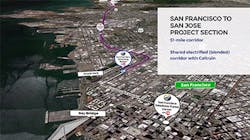The California High-Speed Rail Authority (Authority) Board of Directors adopted the staff recommended Preferred Alternatives for the high-speed rail routes in northern California which comes after nearly a decade of analysis and active engagement with communities along the route.
The staff released its recommendations in July and led a comprehensive outreach effort to provide the board of directors with feedback before bringing its recommendations to them.
“The board’s adoption of the Preferred Alternatives is a major milestone for the high-speed rail program in northern California,” said Brian Kelly, CEO, Authority. “This action allows the Authority to prepare for the next steps in moving the project forward in Northern California. I appreciate the hard work and dedication that our team put into getting this action finalized.”
"This is a positive first step to realizing a true Valley to Valley connection, and ensuring that the community voice is heard," said State Sen. Jim Beall (D-San Jose).
“The process to date has benefited greatly from the engagement of the communities and other local and state entities along the corridor. We look forward to continuing that public conversation as we move forward with the finalizing the draft environmental documents in northern California,” said Northern California Regional Director Boris Lipkin.
In the San Jose to Merced project section, the board identified Alternative 4 as the Preferred Alternative. Alternative 4 utilizes a blended configuration between San Jose and Gilroy in the existing Caltrain and Union Pacific Railroad corridors before continuing to a dedicated high-speed rail alignment through Pacheco Pass.
In the San Francisco to San Jose project section, the board identified Alternative A as the Preferred Alternative. Alternative A utilizes a blended configuration between San Francisco and San Jose within the existing Caltrain corridor. This alternative includes a light maintenance facility on the east side of the tracks in Brisbane and does not include additional passing tracks.
The board’s concurrence directs staff to proceed with project development and to continue to engage local partners to address comments and concerns. Staff will concurrently work to finish the Draft Environmental Impact Report and Environmental Impact Statement (Draft EIR/EIS) for both the San Francisco to San Jose and San Jose to Merced project sections.
The draft environmental documents are due out in early 2020 for the San Jose to Merced project section and in spring 2020 for the San Francisco to San Jose project section. While all alternatives will be evaluated equally in the draft environmental documents, identifying the Preferred Alternatives will guide the public as to what is most likely to become the project. Final route decisions will be made at the conclusion of the environmental review process.


